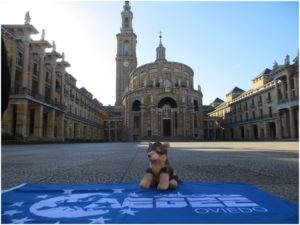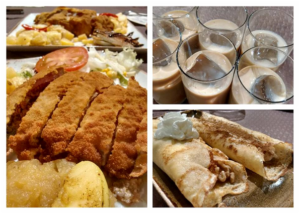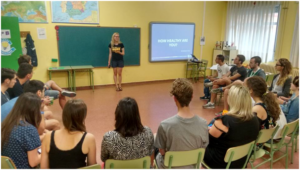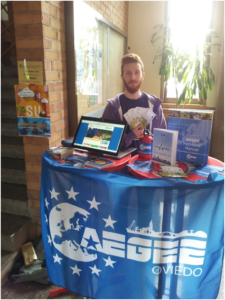Once known for being the largest antenna, nowadays AEGEE-Oviedo is known for its amazing nature and traditions that have nothing to do with the typical image of Spain. In this interview, the board of AEGEE-Oviedo talks about its local’s customs, their famous, adventurous Summer Universities and much more…
 First off, could you tell us something about AEGEE-Oviedo?
First off, could you tell us something about AEGEE-Oviedo?
AEGEE-Oviedo was founded in 1988 by medicine students of Oviedo University. Back in the day, it was the largest antenna in the whole network with almost 2000 members! Hard to believe, as nowadays it consists of 120 members, including nine board members. Some of our members are also involved in European Bodies, and actually one of them is not even human…! Llobu, which means ‘’wolf” in the Asturian language, is our adorable, fluffy mascot!
AEGEE-Oviedo organises a lot of activities throughout the year, ranging from Erasmus activities and various trips, to our Summer University, which is focused on sports and adventure. In most cases, members discover the region Asturias and its many treasures, and visitors find out why this region has nothing to do with the clichés about Spain. For the local members, we organise a lot as well; for example, barbecues, Local Training Courses, chigrequedadas (our social drink meetings, try pronouncing that correctly!), training in non-formal education, sports and other activities. All in all, they do not need to be bored, as if just studying is not enough!
 What kind of traditions or local habits does AEGEE-Oviedo have?
What kind of traditions or local habits does AEGEE-Oviedo have?
AEGEE-Oviedo takes its traditions from the land the local is set on: Asturias. As mentioned above, this region has little in common with the stereotypical image of Spain with flamenco, paella and infinite sunny beaches. In our region, green mountains with snowy peaks, and wavy beaches between high cliffs are more the thing.
As you might have seen in most of the latest promotional videos, there is an appearance of bagpipes. Because this is a Celtic land, there is no flamenco to be found here; that’s from the Andalucían region in the south. We are proud of the fact that modern Spain was born in this region, from where the rest of the Iberian Peninsula was retaken from Muslim Caliphates, starting in 722.
Furthermore, our food has nothing to do with paella nor the infamous drink sangría. Fabada (bean casserole with ham and blood sausage) and cachopo (a “meat sandwich”) are the main traditional dishes. Moreover, the proximity to the sea gives us delicious fresh salmon, squid, crab and octopus. Regarding drinks, sidra, which is the local cider from our region is the most popular. Since sidra is not fizzy from itself, we pour it from above our heads into the glass to create a hint of fizziness!
How does this influence us? Well, our social drink meetings usually involve sidra and cachopo, and the sound of bagpipes gives us goosebumps, especially when we are far from home… We focus a lot on telling visitors about the special histories and customs of this place to break the stereotypes about Spain, which are usually just related to Madrid and the Mediterranean coast.
 You organized the Summer University in co-operation with the ‘Health for you’ (H4Y) project group, what did you learn during the SU?
You organized the Summer University in co-operation with the ‘Health for you’ (H4Y) project group, what did you learn during the SU?
For over ten years, our Summer University has been based on sport and adventure. It was the best SU in 2009 and the third best one in 2010. Kayaking, horse-riding, archery, golf, mountain biking, hiking and surfing are some of the activities we have offered. We have to rotate which activities to do every year, as time and money are unfortunately limited. For the SU in 2016 we thought that it would be cool to link it with H4Y due to its characteristics.
Trainings about the power of habits, healthy lifestyle, improvisation theatre and life hacks were delivered by Mayri Tiido, founder of the H4Y Project back in 2012. By these trainings the participants not only gained a broader view of what being healthy is, but also allowed them to reflect on their personal situations and how to improve them.
 What are your most common ways to encourage Oviedo students to become an AEGEE-Oviedo member?
What are your most common ways to encourage Oviedo students to become an AEGEE-Oviedo member?
In order to keep our numbers over one hundred, we participate in the introduction days of the University of Oviedo at the beginning of the academic year, allowing students to discover us and our activities. Furthermore, we invite everyone, who’s interested, to a barbecue where we explain what AEGEE is. Throughout the year we encourage members to bring a non-AEGEEan friends to any event, so that they can discover the association.
Then, when the SU period comes, we release our ‘second net’; giving sessions about the project and giving away SU Maps (which one of our current board members created by the way!). After this period we get a large amount of new members that we try to keep active, both before and after the SU-period.
How would you describe AEGEE-Oviedo in three words?
Nature, friends and awesomeness!
Written by Susan Nijsten, AEGEE-Groningen

